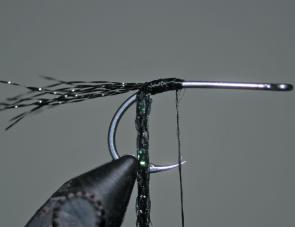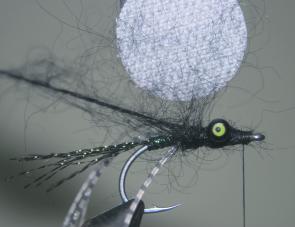This month’s pattern has attributes of a few different flies and, although it doesn’t imitate any particular food item too closely, it definitely produces strikes from a broad array of species in saltwater and fresh.
The Scruffy Charlie is a clone of the highly popular Crazy Charlie pattern that was originally tied for bonefish yet has since proven itself on a large array of species.
The Scruffy Charlie possesses a little more bulk and movement in the water that many other Charlie clones. It can be tied in an array of colours and with many variations to suit different fishing scenarios and species.
The pulsation and movement exhibited by the materials when they are wet is what really makes this pattern enticing and life-like. I am not really sure what the Scruffy Charlie most closely imitates but it does produce strikes.
The particular coloration of the pattern I am tying here is how I first saw the Scruffy Charlie. The angler who showed me this fly had tied it for casting around the pontoons and jetties in canal systems. He had caught many different species on it and I can only imagine that the Scruffy Charlie looked somewhat like the numerous small black shrimps that often reside around the oysters, weed and barnacles on the posts and pontoons in such systems. I have since tied it in a broad array of different colours and have even substituted the materials several times.
The materials used in this pattern have several substitutes and you can really experiment with a broad array of possibilities when tying this pattern.
I have used various chenilles (mainly crystal, estaz, super salt, variegated etc) instead of the Diamond Braid, which is palmered around the hook to form the body. Remember however, that chenille will increase the bulk of the fly and decrease the sink rate.
I have also substituted the rubber legging material with various similar materials and even fine grizzly hackle at times. A different effect and increased movement can be achieved by tying the rubber legs at a 90º angle across the hook shank, to give more of a crab or insect appearance.
Different kinds of flashes in numerous colours can really provide some highlight and these will catalyse strikes from hesitant fish.
The style and weight of the pattern’s eyes can be varied for waters of different depths and current flow. Leech yarn has few substitutes other than various forms of dubbing (Lite-brite, Antron, Lazerlights, etc), however for ease of use and simplicity I prefer to use the Leech Yarn.
You could tie this pattern on a broad array of hook patterns. I prefer the Gamakatsu SL12S for saltwater use and a stinger pattern such as the Gamakatsu B10S for freshwater applications.
Crazy Charlie patterns, including the Scruffy Charlie can be fished in several ways.
The angler I first met who was fishing this pattern simply allowed it to drift in under the jetties and pontoons with the current, only giving it an occasional twitch. He was doing very well on bream and a few other species. Generally the Scruffy Charlie got eaten on the drop probably because it would have looked extremely life-like when fished in current in this manner.
Other approaches could include casting it up current and then retrieving the Scruffy Charlie back with the current, using a series of short strips and pauses to breathe life into it. This retrieve can also work well when casting the pattern across current.
In the freshwater impoundments (which have virtually no current), or other low current areas, this pattern can be fished close to the bottom by allowing it to sink down and then using either several short strips or a single long strip and allowing the pattern a good degree of time to again sink back to the bottom. This is especially worthwhile when targeting shut down bass that will often be residing close to the bottom and are very lethargic in their movements and eating pattern.
This small profile with its vibrant action can be just the thing to turn the tables in your favour. I have used this fly to only take bass, flathead, bream, tarpon and spangled perch during the few times I have fished it. However, I could also see it working well on trevally, saratoga, jungle perch, silver perch and a host of others.
(1) Secure your hook in the vice and attach the thread with a jamb knot roughly opposite the barb. Cut 8-10 strands of Krystal Flash that are roughly as long as the entire hook and tie in at this point.
(2) Attach the end of the Diamond Braid at this same point with the material facing backwards as shown. This will allow you to cover the thread area when palmering the material forward along the hook shank.
(3) Advance the thread forward along the hook shank right up to the hook eye to lay down a bed of thread. Return back around 5mm from the hook eye and then attach the I-Balz with a series of figure-of-eight wraps until they are secure. Come further back along the hook shank around another 5mm and then tie in four rubber legs (two on each side). Whip finish at this point and add a little vinyl cement to the thread.
(4) Take the Diamond Braid and palmer it forward, ensuring not to tie down the rubber legging material. In fact you can make this material stand proud of the body at this stage by pushing it forward slightly as you advance the Diamond Braid. Wrap around the eye of the fly in a figure-of-eight once and then tie off the tag end just behind the hook eye. Whip finish and add a little vinyl cement to the thread.
(5) Tie in the end of the Leech Yarn at this same point and start wrapping around the nose cone area, I-Balz and as far down as where the legs protrude. As you do this, use the hook side of some velcro to tease out the fibres of the leech yarn. Tiewell have a handy little tool for this purpose that makes this task a degree easier. Tease any fibres backwards before doing each subsequent wrap forward. Tie off the end of the Leech Yarn just behind the hook eye, whip finish, cut away the remaining thread and add some vinyl cement to the thread.
(6) Use your velcro to again tease out and roughen up the errant fibres of the Leech Yarn to create a really scruffy look to your pattern. Your Scruffy Bugger is now ready to tempt a broad array of species in saltwater or freshwater.
MATERIALS
| HOOK: | Gamakatsu SL12S #2 |
|---|---|
| THREAD: | Flat-waxed nylon – black |
| EYE: | I-Balz – small black |
| FLASH: | Krystal Flash – black pearl |
| BODY: | Diamond Braid – black |
| LEGS: | Sili-Legs – barred pearl/silver |
| COLLAR: | Leech Yarn – black |
| FINISH: | Vinyl cement |










